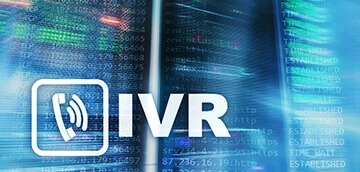Is Your Self-Service IVR as Effective as it Could Be?
IVR is a widely used contact channel because it allows customers to accomplish simple and straightforward tasks independently and conveniently. Interactive Voice Response (IVR) is a telephony menu system that enables the dial pad for identification, segmentation, and routing of callers to the most appropriate agent in your contact center. Even though companies are providing new contact channels such as web portals, chatbots, and mobile apps, the self-service IVR channel still accounts for 73% of contact center traffic!

Unfortunately, 85% of customers still find self-service IVR systems hard to navigate. Too often, customers become frustrated with the system at some point in their IVR journey and ask to speak to a live agent. When surveyed, 60% of customers say they prefer to bypass the IVR and connect to a live agent right off the bat.
So why not scrap the IVR channel and hire some more agents to make customers happy? The question is rhetorical and the answer is obvious.
According to recent data from Forrester, a live agent costs $6-12 dollars per interaction whereas an automated interaction costs about 25 cents. When implemented properly, self-service IVR allows customers to solve their own problems and obtain the information without speaking to live agent at all. When implemented intelligently, self-service IVR routes customers to the agent who is most appropriate and qualified to meet their needs. Clearly, the ROI on IVR can be huge.
When we consider the significant cost savings and efficiency benefits that self-service systems IVR systems can achieve, it’s well worth the investment and effort to make the IVR customer journey as effective and satisfying as it can be.
Self-Service IVR. What could go wrong?
When organizations set up an IVR system, they take great pains to make the menus clear and the flows logical. But apparently, something is getting lost in translation. Why and where are callers dropping off? Do they have to call back repeatedly before they accomplish what they set out to do? Are callers getting hung up in a particular navigation segment or in several places? Companies need to be able to see and understand where customers are struggling (and succeeding) before they can craft satisfactory self-service options.
Another part of the problem is that IVR isn’t alone anymore. Consumers want more contact channels, so companies are giving them more options. At the same time, consumers expect businesses to guide them to the right channel – the one that will resolve their issues in the fastest and best way possible. We don’t want to waste our time figuring out where to go to get the job done or which channel we should use. With the rise of the omnichannel customer experience, IVR systems need to understand exactly who’s on the line (personal), what they want (contextual), and what’s the best path to resolution for that person (intuitive).
Self-Service IVR: Making the Experience Exceptionally Good
Achieving exceptional customer experience each and every time is tough. Self-service has the potential to shift customer behavior and transform the contact center workforce. But you need a game plan. One that involves both strategy and technology to optimize IVR processes and enable satisfactory self-service IVR journeys for your customers.
Part of the strategy involves applying self-service to the right situation. Don’t be too liberal, because not every problem can be solved through self-service, so better to apply to processes where it makes the most sense and where customers will intuitively look to IVR as their contact channel of choice. Apply self-service to situations that are easily predicted. Then use analytics and optimization technologies to evaluate all your IVR interactions in the context of the complete customer journey.
To that end, NICE IVR Optimization solutions and NICE-Nexidia IVR Journey Analytics provide actionable insights on the best ways to streamline contact center operations and boost customer self-service.
NICE IVR Optimization
NICE IVR Optimization solutions automatically gather and display all IVR-related information in a dynamic mapping sequence of the complete customer journey. Armed with a clear view of flows, containment rates, bottlenecks, drop-offs, and call transfers, agents can analyze the data by demographic factors, identify the success and failure of authentication flows, and take advantage of out-of-the-box reports and dashboards for in-depth analysis. Using NICE IVR Optimization, our customers have achieved millions in annual savings by:
- Reducing Repeat Calls: One company mapped all their IVR calls into nearly 400 different caller intents in order to analyze the IVR experience in depth. By clarifying root causes and common IVR journeys for repeat callers, they made critical changes to the IVR process and achieved happier customers and complete ROI in just two months.
- Increasing IVR Containment: Using insights from their NICE IVR Optimization, an enterprise eliminated more than 40,000 calls to the contact center per year by adding an ACH (Automated Clearing House) payment option to the IVR menu. Furthermore, each percentage of additional IVR containment they achieve eliminates 980,000 calls to the contact center and more than $5.5 million in operational costs. The value of these savings far surpass their overall technology investment.
- Improving Customer Journeys: By drilling down into the data of a specific customer journey, an insurance provider discovered a 30-step process through their IVR system. This long IVR interaction usually ended by sending frustrated customers to a live agent. NICE IVR Optimization revealed problematic flows and operational bottlenecks that helped the provider streamline the journey into far fewer steps and significantly reduce the call transfer rate.
Self-Service IVR: Make it the Best it Can Be
While it’s not the sexiest in the bunch, self-service IVR is an important channel for customer interactions with your company. Do your company, your call center and your customers a favor. Use NICE Nexidia IVR Optimization to reduce call center costs, improve the customer experience, and make your self-service IVR a source of exceptional customer satisfaction and loyalty.

